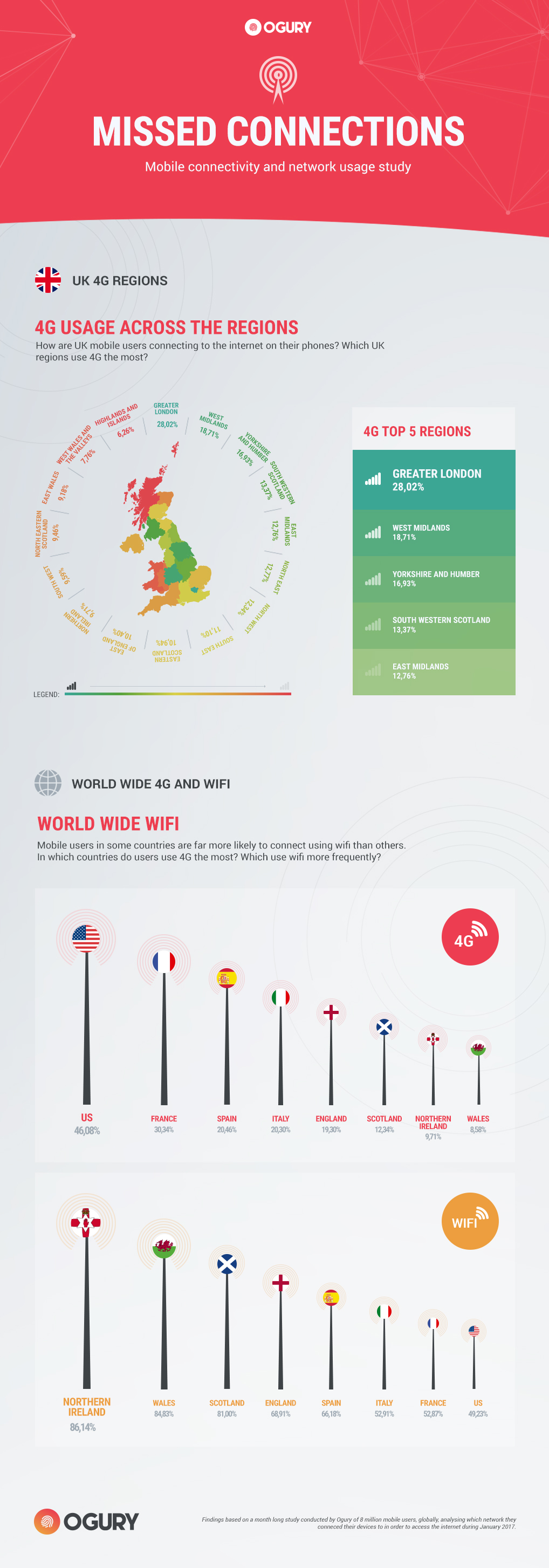5G networks are projected to cover a third of the world’s population within the next decade – and the impact on the mobile industry and its customers will be profound: The new generation of technology will usher in a new era of global connectivity, with networks adapting to applications and performance being tailored to the needs of the user. Are you ready?
There’s much talk about the movement to 5G over the next few years, but are we really ready for the change? Our recent research found that people in the UK are connecting to the web on mobile nearly three times more frequently using Wi-Fi than they are 4G, suggesting that the fast-track to 5G has barriers to overcome in terms of on-the-go user preference. Across the world, we’ve seen varying trends in terms of the battle between 4G and Wi-Fi, but the fact of the matter is, we cannot make assumptions about how people connect without an in-depth understanding of the data behind this.
Gartner believes 2017 is the year data and analytics go mainstream and, as we hit the half-way point of the year, it’s hard to argue with that assertion. But what do advertisers need to consider to ensure they’re making the most of this trend? In this hyper-connected, multi-device mobile age, people are always ‘on’. The result is more digital touch-points and more data are being generated than ever before. While this provides more opportunities to get a deeper understanding of consumers, it also means advertisers need the time and, crucially, the skills to analyse data in depth.
The Internet of Things is set to usher in the next wave of the data revolution, with a staggering 50 billion connected devices projected by 2020. Every consumer interaction with these many new devices will produce real-time and contextual data previously thought unattainable, filling gaps in knowledge of actual consumer behaviour. This explosion of new data will unlock unprecedented value opportunities for brand marketers, while enhancing the customer experience through ever more personalised, relevant and meaningful engagements and relationships.
Reaching the right audiences with the right messages is paramount to achieving the strongest ROI, but first you must consider the broader context of time, location and connectivity. By considering mobile consumption with open and reliable data, advertisers can maximise the impact of an advert on a user – targeting them at the right time and with the right content.
Global connectivity uptake
Our month-long study into the worldwide usage of 4G and Wi-Fi across 8 million mobile users, found that users in some countries are far more likely to connect using Wi-Fi than others. The USA is leading the way in their 4G usage, spending 46.08% of their device time connecting in this way; followed by France (30.34%), Spain (20.46%) and Italy (20.30%). Even within nations there are vast disparities – such as in the UK where those in Greater London use 4G for 28.02% of their connected device time, compared with just 6.26% in West Wales and The Valleys and 6.26% in the Scottish Highlands and Islands.
When it comes to Wi-Fi, it’s not just Brits that are connecting regularly. Spain logs on using Wi-Fi 66.18% of the time on mobile, with Italy (52.91%), France (52.87%) and the US (49.23%) following suit. Clearly, many areas rely heavily on Wi-Fi for the vast majority of their connections. Whether this is down to poor 4G availability, the personal preferences of individuals, or even the cost of data plans, these factors could cause challenges for the adoption of 5G.
Disparities between regions within a nation mean we must pinpoint the location of our audience and develop the strategies to connect with them. For those targeting across borders, or even across counties, location must be taken into account when planning adverts. So how does your strategy change?
Audience of one
Assumptions aren’t good enough when advertising budgets are at play. Not every woman in her 30s is a parent, nor does every man show interest in cars – so understanding the end user really is crucial. Utilising these insights necessitates an understanding based on facts – with data being the key.
In this data driven digital era, businesses and marketers must recognise that the new normal is an audience of one. Identifying and targeting consumers based on individual behaviours and personalities is the only way to ensure success. Online video streaming sites such as Netflix and Amazon Prime are simple yet effective examples of behavioural targeting: analysing previously watched items and giving further suggestions based on tastes and habits. Gone are the days of ‘catch-all’ generic demographic-based audience segmentation. Consumers themselves now expect tailor-made, relevant content.
Laser planning
To really target the individual, their behaviour needs to be understood from the early stages of content creation. Creatives developing video-based campaigns should consider the connectivity of audiences as those connecting via 2G or 3G, for example, may find video content a struggle to watch.
Marketing departments have already recognised the potential for mobile-based videos, with some already making a switch to shorter 15-second films and vertical content that suits smartphone screens. It’s only with a full understanding of context that advertisers can decide which content to show – and which to create.
Context marketing
Data driven marketers must consider the consumer environment and broader consumer context when looking to reach and engage with different types of content. Context can be key to deciding what type of content is delivered and when is the optimum time to grab the attention so it aligns with what they are doing.
How a user is connecting to the web on mobile can be indicative of their receptiveness to messaging. Wi-Fi suggests that a user may be at home or more settled, so might be in better a position to sit and digest longer-form content. Big purchases such as cars and new technology requires a customer to really sit and think about whether they are ready to buy, so targeting ‘on the go’ could negatively impact conversion rates.
Connectivity has a huge influence over the level of data consumers are able to receive, so this influences the receptiveness towards a product or service. Those connecting via 4G may be more likely to make snap purchases, so advertisers looking to promote games, music or audiobooks should consider how they access commuters and those wanting immediate entertainment.
About time
Environment and time of day often come hand-in-hand. In many cases, advertising can work better when connected to Wi-Fi due to its faster speeds and better connectivity, with data being the key to understanding when this is for your audience. The most effective mobile advertising campaigns understand how to target consumers with just the right content, at just the right time.
This can only be achieved with a thorough understanding of consumers and how they behave. Robust targeting is dependent on having a truly accurate view of unique mobile user behaviour, and only by analysing the data in depth can brands understand the complete mobile journey of a potential customer. This means knowing what they do and when they do it, so the delivery of useful and relevant content is aligned to daily routines.
If a brand wants to reach a target user with a video ad that the behaviour profile tells them will resonate, it’s vital to consider where they are. If they are in area with 2G or 3G coverage, there is likely to be some lagging. Only by understanding your audience’s usual behaviours can you make decisions on whether they’re at home or using a strong connection on a typical Monday evening.
We are moving ever closer to a 5G world, but we’re far from there yet. Without brands fully understanding how connectivity impacts the ability of consumers to engage with content, campaign effectiveness will suffer, no matter how relevant the product. Around the world, the location of an individual will dramatically impact connectivity trends. Unlocking the data already held in mobile devices is the key to ensuring audiences are receiving only the advertising that is right for their tastes and situation.
Have an opinion on this article? Please join in the discussion: the GMA is a community of data driven marketers and YOUR opinion counts.
Read also:
Mobile search: data driven tips to optimise your marketing
Bigger, stronger, faster: Why the impact of Phase 3 of the digital evolution will be huge







Leave your thoughts